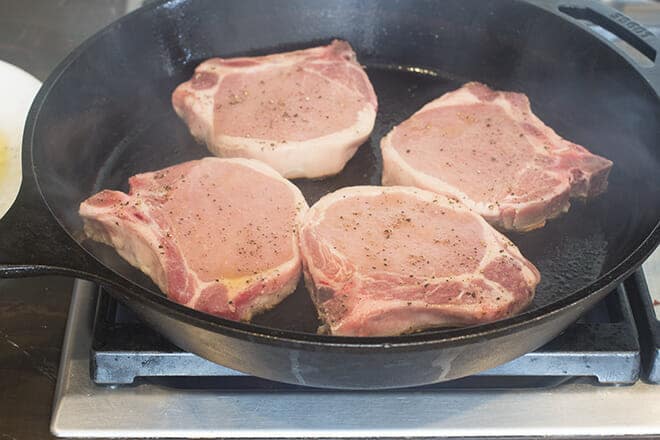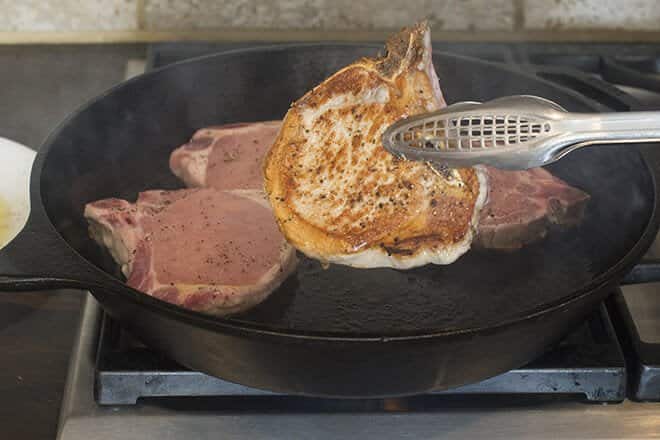Find out how to cook pork chops perfectly so that they’re juicy and delicious every time.
Pork chops are so tasty, and they’re quick and easy to cook. This makes them a great choice for weeknights, or for anytime, really.
As good as pork chops are though, sometimes they can end up a bit dry. Here I’m going to give you a foolproof method for making juicy and tender pork chops every time. This recipe is for cooking pork chops on the stove. Below are links to my other pork chop recipes.
To find out more about how it all works, scroll down or click here. Now you can go straight to the recipe.
Pork chops are a delicious and versatile meat that can be prepared in many ways. While grilling, pan-frying, and baking are popular methods, boiling is also an easy option for cooking juicy, flavorful pork chops. But how long should you boil pork chops to ensure they turn out perfectly cooked?
The boiling time for pork chops depends primarily on their thickness. Thinner chops will cook faster, while thicker chops need more time in the boiling water. Bone-in chops also require additional cooking time compared to boneless.
Follow this guide to learn exactly how long to boil different cuts of pork chops. With a few simple tips you’ll be able to boil pork chops so they come out moist tender and safe to eat every time.
Factors That Affect Boiling Time
There are a few key factors that determine how long pork chops need to boil
Thickness
The thickness of the pork chops is the most important factor. It takes less time to cook chops that are about 1/2 inch thick than chops that are 1 inch or thicker.
As a general guideline:
- 1/2 inch thick chops: boil for 8-12 minutes
- 3/4 to 1 inch thick chops: boil for 15-20 minutes
- 1 1/2 inches or thicker chops: boil for at least 25-30 minutes
Bone-In vs Boneless
Bone-in pork chops take longer to cook than boneless. The bones help insulate the meat, slowing down the cooking process.
Boneless chops will be done boiling in 15-20 minutes usually, while bone-in chops need 20-25 minutes.
Size of Chops
Larger pork chops naturally require more boiling time than smaller pieces. If the chops in a batch are very different sizes, keep a close eye on them as they boil.
Amount of Chops
Boiling a large batch of pork chops causes the pot to cool down when you first add them in. This extends the overall cooking time. Boil smaller amounts (2-4 chops) for the minimum recommended times.
Temperature of Water
If you start with hot tap water, it will boil again faster than if you use cold water. The chops will cook faster in steadily boiling water.
Step-By-Step Boiling Instructions
Follow these simple steps for perfect boiled pork chops every time:
-
Fill a large pot about halfway with hot tap water and bring to a boil over high heat.
-
Add the pork chops gently to the boiling water. For bone-in chops, boil for 20-25 minutes. For boneless chops, boil for 15-20 minutes.
-
After the minimum boiling time, check the internal temperature by inserting an instant-read meat thermometer into the thickest part of a chop. The temperature should reach 145°F for safe consumption.
-
If the chops are not yet at 145°F, continue boiling and checking the temperature every 2-3 minutes until they reach the target temp.
-
Once cooked, remove the chops from the water immediately and pat dry. Avoid overcooking as this causes them to become rubbery.
-
Optionally, add extra flavor by boiling the chops in broth, wine or beer instead of plain water. Boil bone-in chops with vegetables like onions, carrots, celery and garlic.
Tips for the Best Results
Use these tips for ensuring your boiled pork chops turn out perfect:
-
Pat the chops dry before boiling to help them brown better in the hot water.
-
Don’t crowd the pot. Boil chops in a single layer with space around each piece for even cooking.
-
Turn the chops over halfway during boiling to cook both sides evenly.
-
Check temperature early and often. Pork reaches safe temp before it looks done.
-
Allow chops to rest 3-5 minutes before serving. This allows juices to redistribute.
-
Add herbs, spices or sauces after boiling to boost flavor. Avoid adding them before or during boiling as they can cause the water to foam and boil over.
Cooking Boneless vs. Bone-In Pork Chops
There are pros and cons to each type of pork chop when boiling:
Boneless pork chops
- Cook faster compared to bone-in chops
- More tender since connective tissues are removed
- Easier to serve without bones
Bone-in pork chops
- More flavorful due to bones and fat
- Bones help chops hold their shape better
- Less likely to dry out during cooking
Ultimately, the choice comes down to personal preference. Follow the guidelines above to boil each type perfectly.
How to Know When Pork Chops Are Done Boiling
It can be tricky to tell when pork chops are fully cooked by sight alone. Here are some ways to test doneness while boiling:
-
Use an instant-read thermometer to check internal temp. 145°F is the safe minimum.
-
Insert a knife into the thickest part of a chop. It should slide in and out easily when fully cooked.
-
The meat should appear opaque all the way through with no pink color left. But take temp too since pork can sometimes still look a bit pink when safely cooked.
-
Check that the meat feels firm when pressing on it. Soft, mushy meat means it needs more boiling time.
Don’t rely solely on the recommended boiling times. Always confirm doneness with a thermometer for food safety.
Serving and Storing Boiled Pork Chops
Boiled pork chops make a quick, healthy weeknight meal. They pair well with a variety of easy sides like mashed potatoes, rice, roasted veggies and salads.
For best flavor and texture, serve them immediately after cooking. If needed, you can hold cooked pork chops up to 2 hours by keeping them warm in a 200°F oven.
To store leftovers:
-
Allow chops to cool completely, then refrigerate in shallow airtight container.
-
Use refrigerated boiled pork chops within 3-4 days.
-
Reheat gently in simmering water, broth or gravy until heated through. Avoid overcooking when reheating.
From quick weeknight dinners to easy Sunday suppers, boiled pork chops are a tasty and reliable meal option. Master the simple boiling method and timing for moist, delicious chops anytime.

Cooking The Pork Chops
Heat a large oven-safe skillet over high heat. I use a 12-inch cast iron skillet. I know 12 inches doesn’t sound like much but it’s ridiculously large and heavy. 12 inches is the interior diameter, that is, the entire flat cooking surface of the inside of the pan is 12 inches across. It easily fits the 4 pork chops without crowding them so they can brown up nicely.
If your pan is smaller, you might have to use two pans. You can also brown the chops two at a time on the first side, then put all four of them together on the second side to finish in the oven.
Put the pork chops in the hot pan on the stove when the oven is ready (you want the oven to be ready when you need it).

Also, keep in mind that I didn’t add any oil to the pan; I just oiled the chops. This is helpful because the pan can get really, really hot and still not smoke and burn the oil. It might smoke when you put the oiled chops in the hot pan, but the oil won’t burn. Instead it will use the oil to help the chops turn a nice deep brown.
How To Sear Pork Chops
Cook the chops without moving them AT ALL for 3 minutes. Then use a pair of tongs to try gently lifting one up. If it is still stuck to the pan, let it go and cook for one or two more minutes. Then try to lift it again.
When a good crust is formed on the meat, it will then release more easily from the pan. When they’re nice and brown like below, you can flip them over.

Once you flip them all over, transfer the skillet (uncovered) to the preheated oven.

Unlock the Secrets to Perfect Pork Chops | Pro Tips Revealed
FAQ
How do you know when pork is fully boiled?
Can you cook pork chops in water?
How long should I boil pork for it to be tender?
How long are pork chops supposed to be cooked?
